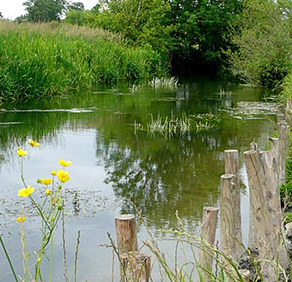 The Holy Brook runs for six miles as a channel of the River Kennet, flowing to the north of the main channel from Arrowhead at Theale and then rejoining it in the centre of Reading, just downstream of the Abbey Mill by the prison.
The Holy Brook runs for six miles as a channel of the River Kennet, flowing to the north of the main channel from Arrowhead at Theale and then rejoining it in the centre of Reading, just downstream of the Abbey Mill by the prison.
Part of the brook flows underneath Reading town centre before rejoining the Kennet by Reading Abbey. It powered the watermill of Reading Abbey, hence its name of the Holy Brook.
A side stream of the brook runs into the Kennet again at Calcot and also powered the Calcot Water Mill, which was owned by Reading Abbey. Some parts of the channel are natural, whilst other parts were created in medieval times to supply water to water mills and fish ponds. The Holy Brook is part of a network of streams which drain the Kennet Water Meadows, one of the few remaining areas of open countryside close to the centre of Reading. The area is an important, accessible open space, valued for both wildlife and recreation, including walking, fishing and bird watching.
The Holy Brook is recognised as a key spawning habitat for coarse fish, particularly barbel and chub.
Its waterbody status is moderate due to dissolved oxygen.
Actions required:
- Source to weir at Rose Kiln Court: Calcot Mill forms a complete barrier to fish migration and causes a significant impoundment upstream. There is potential to achieve fish passage on at least one of the channels which exit the brook upstream of the mill by installing a technical fish pass and, as one of the structures around the mill is currently failing, there may be an opportunity to do some works in the near future. A walkover of the entire stretch is required to identify enhancement options.
- Reading: restoration is required on this stretch of the brook but is not compatible with the urbanised setting. We rely on planning gains as and when redevelopment takes place to secure enhancement work.

